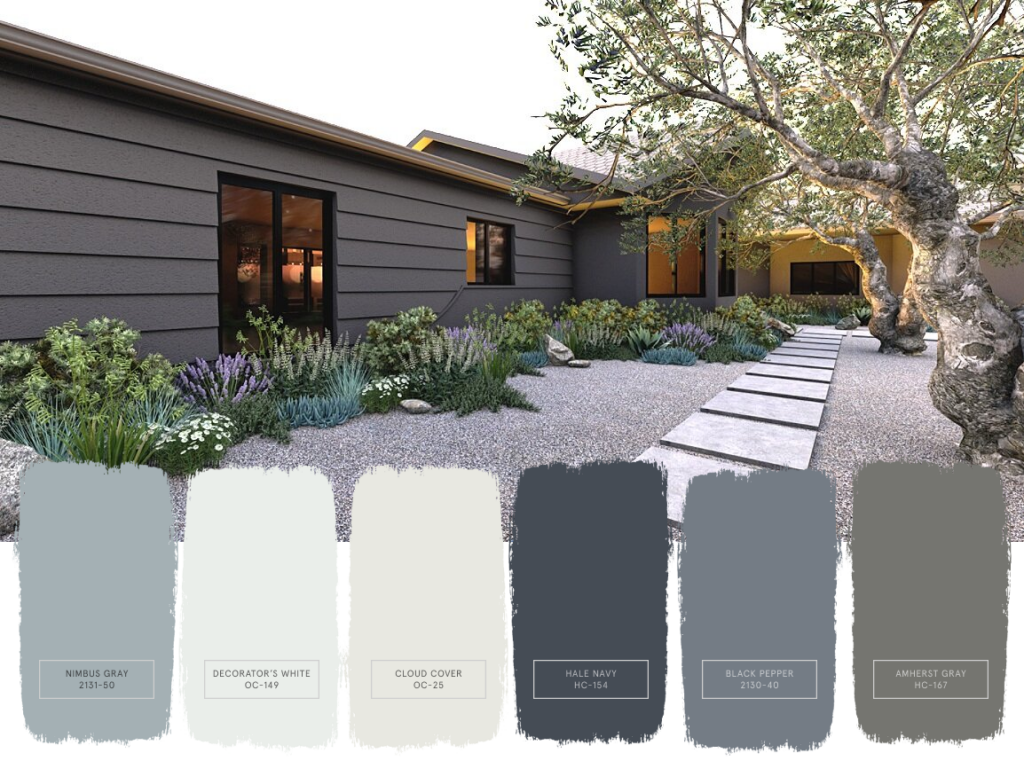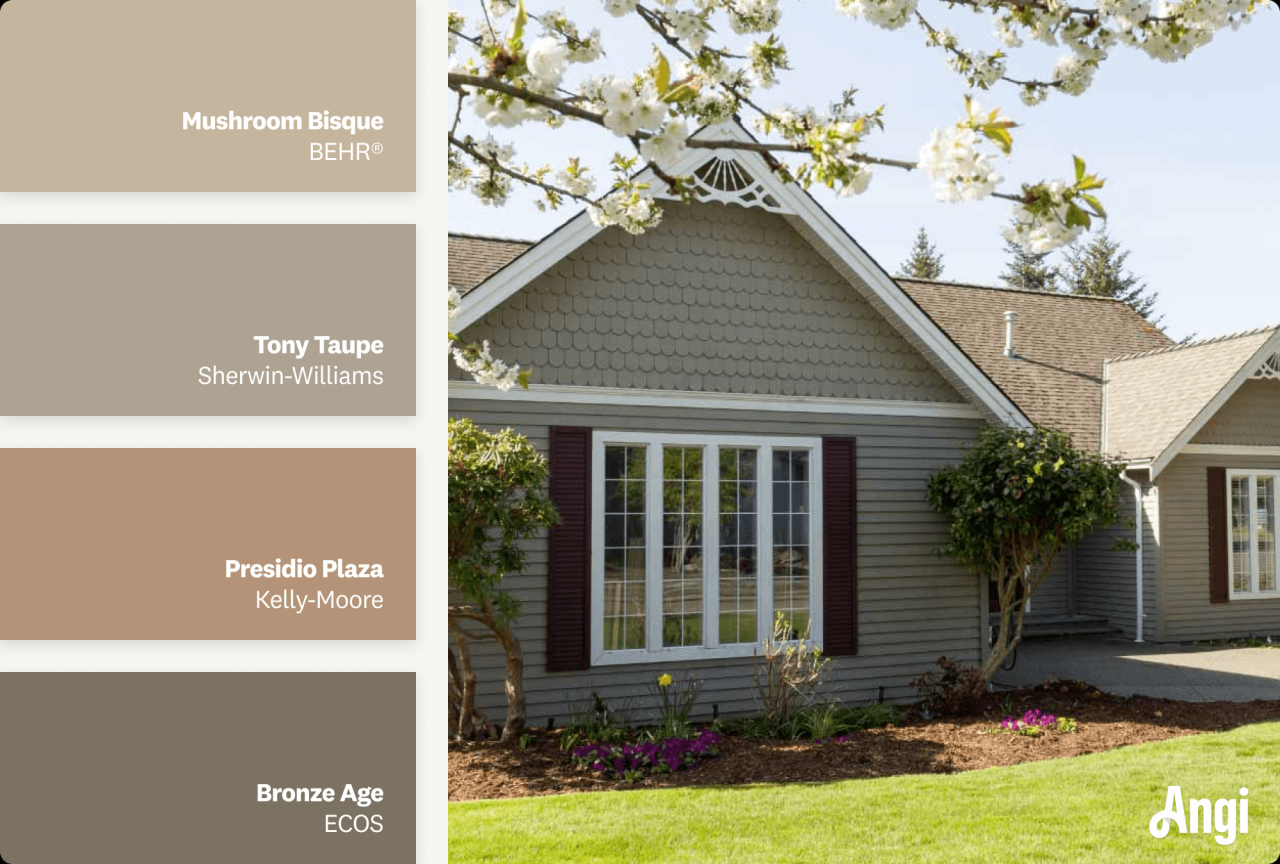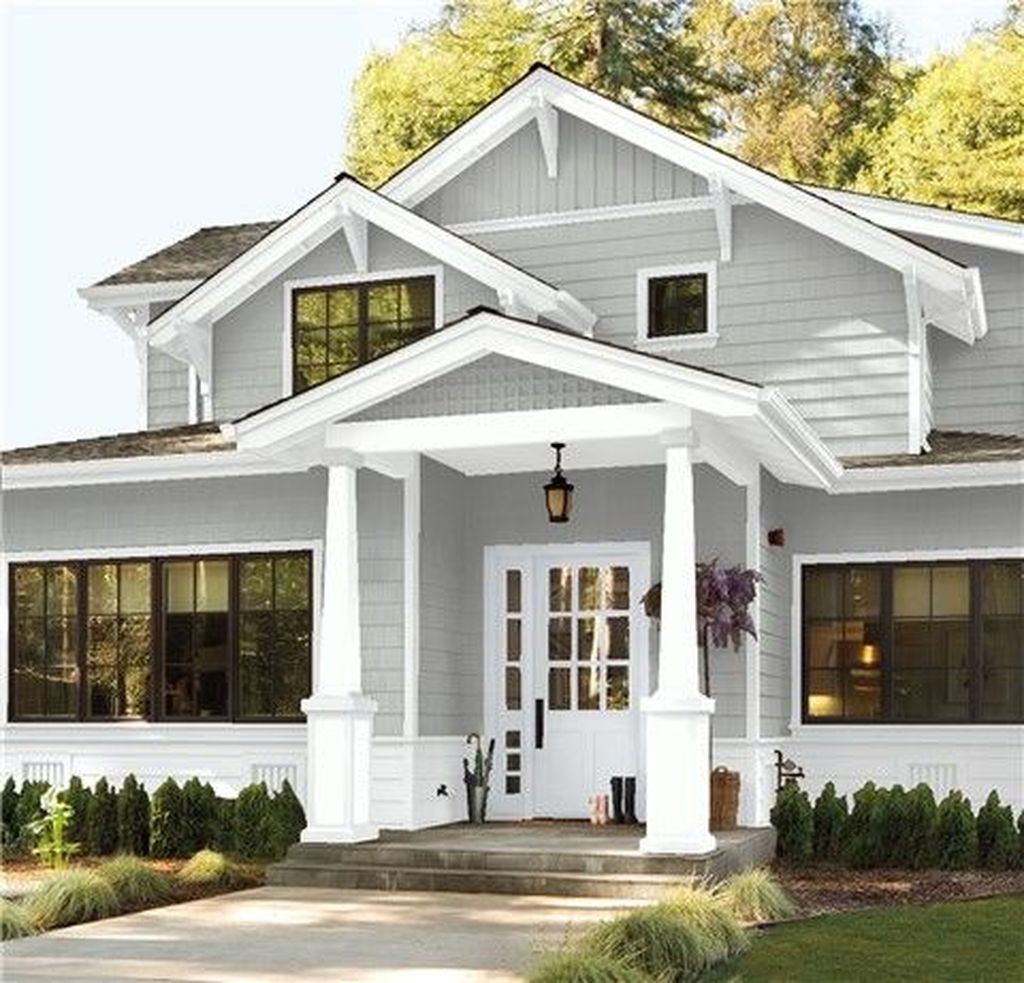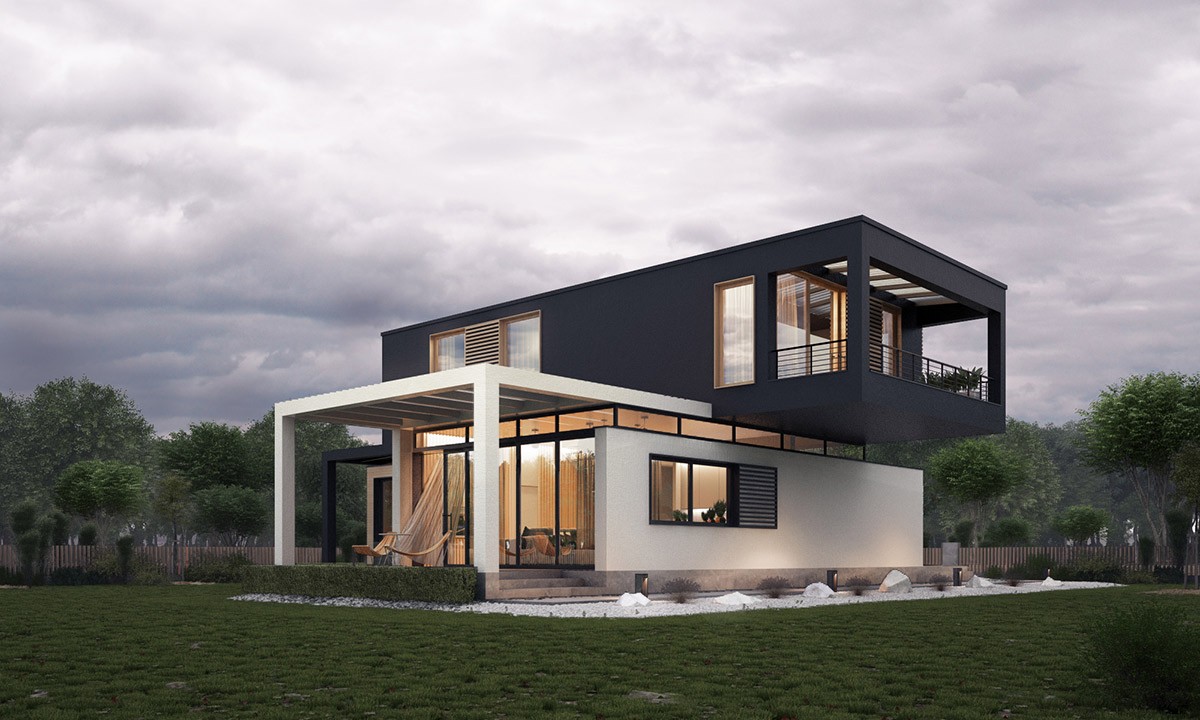Best classic modern home exterior paint colors—the phrase alone evokes images of sleek lines, sophisticated palettes, and homes that effortlessly blend timeless elegance with contemporary flair. Choosing the right exterior paint can dramatically impact your home’s curb appeal, setting the stage for a welcoming and stylish entrance. This guide delves into the art of selecting the perfect hues for your classic modern dream home, exploring neutral bases, accent colors, and the influence of lighting and landscaping.
From understanding the architectural nuances of classic modern design to mastering the interplay of colors and materials, we’ll navigate the key considerations for achieving a truly stunning exterior. We’ll showcase inspiring examples, offer practical tips for preparation and application, and even address regional variations in style to ensure your home reflects its unique location and personality. Get ready to transform your home’s exterior into a masterpiece!
Defining “Classic Modern” Home Exterior Style: Best Classic Modern Home Exterior Paint Colors

Classic modern architecture strikes a harmonious balance between timeless elegance and contemporary simplicity. It’s a style that avoids overly ornate detailing while embracing clean lines and sophisticated materials. Unlike purely contemporary designs which can feel stark, classic modern homes retain a sense of warmth and inviting character. This blend of old-world charm and modern sensibilities makes it a perpetually popular choice for homeowners.
Classic modern homes are characterized by a careful selection of architectural features that create a sophisticated and enduring aesthetic. The style often draws inspiration from mid-century modern design but incorporates elements that enhance its longevity and appeal. This isn’t about fleeting trends; it’s about creating a home that remains stylish for decades to come.
Classic Modern Design Elements
Classic modern home exteriors are defined by several key elements. These elements work together to create a cohesive and visually appealing design. Understanding these elements is crucial for identifying and appreciating the style.
Rooflines typically feature low-pitched gables or flat roofs, sometimes incorporating subtle variations in pitch for visual interest. Window styles are often large and expansive, maximizing natural light and creating a connection between the interior and exterior spaces. Picture windows, casement windows, and sliding glass doors are frequently used. Materials are carefully chosen to complement the clean lines of the architecture.
Common materials include stucco, brick, stone, and wood, often used in combination to create texture and visual interest. The use of natural materials adds to the sense of timelessness and sophistication.
Comparison of Classic Modern with Other Architectural Styles
The following table compares and contrasts classic modern homes with traditional and contemporary styles, highlighting their key differences in design elements and overall aesthetic.
| Feature | Classic Modern | Traditional | Contemporary |
|---|---|---|---|
| Roofline | Low-pitched gables, flat roofs, subtle variations in pitch | Steeply pitched roofs, complex rooflines, dormers | Flat roofs, minimal rooflines, sometimes inverted roofs |
| Window Styles | Large, expansive windows; picture windows, casement windows, sliding glass doors | Smaller, more numerous windows; often multi-paned | Large expanses of glass, floor-to-ceiling windows, unusual window shapes |
| Materials | Stucco, brick, stone, wood – often in combination | Brick, wood siding, stone, often with decorative trim | Concrete, steel, glass, often with minimal ornamentation |
| Overall Aesthetic | Clean lines, simple forms, sophisticated materials, timeless elegance | Ornate details, symmetrical design, traditional proportions, historical influences | Minimalist design, geometric shapes, open floor plans, emphasis on functionality |
Color Palette Exploration

Neutral paint colors are the cornerstone of a classic modern home exterior. Their versatility allows for a clean, sophisticated look that transcends fleeting trends. The subtle variations in shade and undertone within the neutral family offer a surprising range of aesthetic possibilities, from cool and minimalist to warm and inviting. Mastering the art of choosing the right neutral is key to achieving that effortlessly chic classic modern style.The impact of different neutral shades on a classic modern home’s aesthetic is significant.
A light grey, for example, can create a feeling of spaciousness and airiness, while a warm beige can evoke a sense of comfort and groundedness. Darker greys or charcoal hues can add drama and sophistication, especially when contrasted with lighter accents. The subtle differences in undertones—whether cool, warm, or even slightly green or pink—can dramatically alter the overall feel of the home, influencing how it interacts with natural light and its surroundings.
Neutral Paint Colors for Classic Modern Homes
Selecting the perfect neutral requires considering the home’s architecture, its surroundings, and the desired mood. Here are five neutral paint colors that frequently grace the exteriors of classic modern homes, along with their undertones and suggested applications.
- Agreeable Gray (Sherwin-Williams): This popular choice boasts a slightly warm, greige undertone. It works beautifully on larger homes, providing a sophisticated and timeless backdrop that complements various landscaping styles. Imagine a two-story home painted in Agreeable Gray, with crisp white trim and dark grey window frames, creating a balanced and refined aesthetic.
- Repose Gray (Sherwin-Williams): A cooler grey with subtle blue undertones, Repose Gray is perfect for homes seeking a more contemporary and sleek feel. It pairs well with modern materials like metal and glass, creating a crisp, clean look. Picture a single-story home with clean lines, painted in Repose Gray, accented by black window frames and a sleek, minimalist landscape.
- Swiss Coffee (Benjamin Moore): This off-white offers a creamy, warm undertone. It’s a versatile choice that brightens the exterior without being stark. Swiss Coffee can create a welcoming and inviting atmosphere, especially on smaller homes or those situated in shaded areas. Envision a cozy cottage-style home painted in Swiss Coffee, complemented by dark brown accents on the door and window trim, creating a sense of warmth and charm.
- Pale Oak (Benjamin Moore): This light beige possesses subtle taupe undertones, creating a neutral that feels both sophisticated and calming. It works well in various climates and complements both traditional and modern landscaping. Imagine a mid-century modern home, painted in Pale Oak, with natural wood accents and a lush green lawn, achieving a balanced and harmonious effect.
- Iron Ore (Sherwin-Williams): A dramatic choice, Iron Ore is a deep charcoal grey that adds a striking and modern edge to classic architecture. It works best on larger homes or those with significant architectural detail, creating a powerful and sophisticated statement. Picture a large, multi-level home painted in Iron Ore, accented by warm brass lighting fixtures and light-colored stonework, forming a striking contrast.
Color Palette Exploration
Choosing the right accent colors can elevate a classic modern home exterior from stylish to stunning. These pops of color add personality and visual interest, preventing the neutral base from feeling bland. Strategic placement of accent colors is key to achieving a cohesive and sophisticated look.
Accent colors should complement, not compete with, the neutral base. They should be used sparingly to highlight architectural details and create focal points. Overusing accent colors can disrupt the clean lines and minimalist aesthetic characteristic of classic modern design.
Accent Color Choices for Classic Modern Homes
Three accent colors that consistently work well with classic modern home exteriors are navy blue, deep green, and terracotta. These colors offer a sophisticated contrast to popular neutral bases like white, gray, and beige, while maintaining a sense of calm and elegance.
Navy blue provides a timeless and refined touch, evoking a sense of sophistication and nautical charm. Deep green offers a connection to nature, adding a touch of tranquility and earthiness. Terracotta introduces warmth and vibrancy, adding a touch of Mediterranean flair. The key is selecting shades that harmonize with your chosen neutral base and the overall style of your home.
Strategic Use of Accent Colors, Best classic modern home exterior paint colors
These accent colors can be strategically implemented to maximize their impact. Consider using navy blue for the front door, creating a bold and welcoming entrance. Deep green can be used for shutters or trim, adding depth and visual interest without overpowering the neutral base. Terracotta can be used for planters, window boxes, or even a portion of the siding, injecting a warm and inviting feel.
The placement and scale of the accent color are crucial in maintaining a balanced and harmonious look.
Neutral Base and Accent Color Combinations
| Neutral Base | Accent Color (Door) | Accent Color (Shutters/Trim) | Suggested Trim Color |
|---|---|---|---|
| White | Navy Blue | Deep Green | Off-white |
| Light Gray | Terracotta | Navy Blue | Medium Gray |
| Beige | Deep Green | Black | Light Beige |
| Warm Gray | Navy Blue | Terracotta | Slightly darker Warm Gray |
Impact of Lighting and Surroundings

Choosing the perfect exterior paint color for your classic modern home goes beyond simply picking a shade you like. The interplay of natural light, the surrounding environment, and even the home’s orientation significantly impacts how the chosen color is perceived. Understanding these factors is crucial for achieving the desired aesthetic and ensuring your home’s exterior looks its best throughout the day and across the seasons.Natural light and the surrounding environment dramatically affect how exterior paint colors appear.
The intensity and angle of sunlight, the presence of shadows, and even the surrounding landscape all play a role. A color that appears vibrant in bright sunlight might look muted in the shade, while a cool-toned paint might appear warmer against a backdrop of lush greenery. The time of day also plays a part; a color may look drastically different at sunrise compared to high noon.
Orientation’s Influence on Color Appearance
The direction your home faces (north, south, east, or west) directly influences the amount and type of sunlight it receives. South-facing facades receive the most direct sunlight throughout the day, making colors appear brighter and potentially even warmer. West-facing walls are often bathed in the warm, golden light of the setting sun, which can dramatically alter color perception. North-facing walls, on the other hand, receive the least direct sunlight, making colors appear cooler and potentially less vibrant.
East-facing walls experience the morning sun, offering a gentler, more diffused light. Consider these variations when selecting your exterior paint, choosing colors that will complement the light exposure throughout the day. For example, a deep navy might look stunning on a west-facing wall at sunset, while a light gray might be a better choice for a north-facing wall to avoid it appearing too dark.
Landscaping and Hardscaping’s Complementary Role
Strategic landscaping and hardscaping can significantly enhance the impact of your chosen exterior paint colors. A vibrant, colorful garden can complement a neutral-toned home, while a minimalist landscape might better suit a bold color scheme. For instance, a home painted in a warm, earthy tone could be beautifully complemented by a garden filled with terracotta pots and drought-tolerant plants in shades of brown, beige, and muted greens.
Conversely, a sleek, modern home painted in cool grays or blues might look striking against a backdrop of carefully manicured lawns and minimalist hardscaping features like clean lines of concrete or natural stone pathways. The interplay between the architectural style, paint color, and landscaping should create a harmonious and visually appealing whole. Imagine a classic modern home painted in a soft white, accentuated by a dark gray roof and contrasting black window frames.
The addition of carefully placed, strategically chosen evergreen shrubs and meticulously maintained lawns would create a stunning, sophisticated, and timeless aesthetic.
Illustrative Examples of Classic Modern Home Exteriors
Choosing the right exterior paint colors for a classic modern home is crucial for achieving a cohesive and stylish look. The interplay of color, material, and architectural details significantly impacts the overall aesthetic. Below are three distinct examples showcasing how different color palettes can transform a classic modern home.
Classic Modern Home Exterior Example 1: Warm Neutrals with Natural Accents
This home features a stucco exterior in a warm, light gray called “Agreeable Gray” by Sherwin-Williams. This neutral base provides a sophisticated backdrop for the natural wood accents found in the front door and window frames, stained a rich, medium brown. The overall effect is calming and inviting, enhanced by the subtle contrast between the cool gray and the warm brown.
Landscaping with lush greenery further complements the muted palette, creating a sense of serene sophistication. The driveway and walkway are made of light-colored pavers, creating a unified look that complements the home’s color scheme.
Classic Modern Home Exterior Example 2: Bold Black and White Contrast
This example showcases a striking contrast between black and white. The home’s primary structure is clad in crisp white stucco, providing a clean, modern base. The windows and front door, however, are painted a deep, matte black, creating a strong visual focal point. This bold color combination creates a dramatic and sophisticated look, highlighting the architectural lines of the home.
The use of black metal accents on the railings and lighting fixtures further reinforces the sleek, modern aesthetic. The landscaping in this case features carefully manicured hedges and minimalist plantings, ensuring that the color scheme remains the focus.
Classic Modern Home Exterior Example 3: Earthy Tones with Metal Accents
This home uses a combination of materials – cedar wood siding painted a muted sage green and light gray stucco accents. The sage green provides a natural, earthy feel, while the gray stucco offers a clean contrast. The metal accents, such as the garage door and window trim, are painted a charcoal gray, adding a touch of industrial chic to the overall design.
This combination creates a sophisticated and inviting exterior that feels both modern and grounded. The landscaping incorporates native plants and gravel pathways, further reinforcing the natural and understated elegance of the design.
| Home Example | Primary Exterior Material & Color | Accent Colors & Materials | Overall Effect |
|---|---|---|---|
| Warm Neutrals with Natural Accents | Stucco, Agreeable Gray (Sherwin-Williams) | Medium Brown stained wood (doors, windows); Light colored pavers (driveway, walkway) | Calming, inviting, sophisticated |
| Bold Black and White Contrast | White stucco | Deep matte black (windows, doors, metal accents); Minimalist landscaping | Dramatic, sophisticated, modern |
| Earthy Tones with Metal Accents | Cedar wood siding (muted sage green); Light gray stucco | Charcoal gray (metal accents); Native plants and gravel pathways | Sophisticated, inviting, natural, modern |
Material Considerations and Paint Choices

Choosing the right paint for your classic modern home exterior isn’t just about aesthetics; it’s about longevity and protecting your investment. The material your home is constructed from significantly impacts both the type of paint you should use and the color you select. Understanding these relationships is crucial for achieving a stunning and durable finish.The interplay between exterior materials and paint selection is complex.
Different materials have varying porosities and textures, influencing paint adhesion and the overall look. Similarly, paint types offer diverse properties in terms of durability, flexibility, and finish, making careful consideration essential for optimal results. Ignoring these factors can lead to premature paint failure, costly repairs, and a less-than-ideal aesthetic outcome.
Exterior Material Influences on Paint Color Selection
The inherent color and texture of your home’s exterior material heavily influence the paint color choices. For instance, a warm-toned brick house might pair beautifully with earthy tones like terracotta or deep browns, enhancing its inherent character. Conversely, a smooth stucco exterior offers a blank canvas, allowing for a wider range of color options, from bold jewel tones to subtle neutrals.
Wood siding, with its natural grain, can be complemented by muted greens, grays, or even whites that allow the wood’s texture to shine through. The goal is to either harmonize with the existing material or create a striking contrast, depending on the desired effect. For example, a dark gray paint on a light-colored stucco house can create a sophisticated, modern contrast.
Paint Type Suitability for Different Exterior Materials
Acrylic and latex paints are the most common choices for exterior applications, but their suitability varies depending on the material. Acrylic paints, known for their durability and resistance to fading, are excellent for a variety of surfaces, including brick, stucco, and wood. Latex paints, often preferred for their ease of application and quick drying time, are also suitable for many exterior materials, but may require a primer depending on the surface.
However, on porous materials like wood, a high-quality, primer-sealer is always recommended to prevent moisture absorption and improve paint adhesion. For materials like fiber cement, specific paints designed for this material are recommended for optimal performance.
Best Practices for Preparing Exterior Surfaces Before Painting
Proper surface preparation is paramount for a long-lasting, beautiful paint job. Neglecting this step can lead to peeling, cracking, and early paint failure.Before you even think about picking up a paintbrush, thorough preparation is key. This involves several crucial steps:
- Cleaning: Remove all loose dirt, debris, mildew, and cobwebs using a pressure washer or stiff brush. For mildew, a bleach solution (following manufacturer’s instructions) might be necessary.
- Repairing: Fill any cracks, holes, or gaps in the surface using appropriate caulk or patching compound. Allow ample drying time before proceeding.
- Priming: Applying a primer is crucial, especially on bare wood or previously painted surfaces with imperfections. A high-quality primer ensures better paint adhesion and creates a uniform surface for even color application.
- Sanding: Lightly sand any rough patches or imperfections after filling and priming to create a smooth surface for painting. Remove all sanding dust before painting.
- Caulking: Seal all gaps and cracks around windows, doors, and other areas where water can penetrate, using exterior-grade caulk. This is critical for preventing water damage and maintaining a weather-tight seal.
Following these steps will ensure a professional-looking and long-lasting finish that will protect your home’s exterior for years to come.
Exploring Regional Variations in Classic Modern Style

The classic modern aesthetic, while inherently adaptable, finds its truest expression through a nuanced understanding of its surroundings. Regional climates, architectural traditions, and even the prevailing landscape significantly impact the choice of exterior paint colors, creating unique variations on the theme. Ignoring these contextual factors can lead to a jarring disconnect between the home and its environment. Successful classic modern design harmonizes with its location, not against it.Regional climates dictate both the practicality and the aesthetic appeal of different color palettes.
Harsh sunlight, frequent rain, or extreme temperatures all influence the longevity and visual impact of exterior paint. Similarly, architectural traditions often inform the appropriate color choices, ensuring the home feels both contemporary and appropriately situated within its historical and cultural context. By carefully considering these elements, we can achieve a truly integrated and visually stunning result.
Coastal Region Color Palettes
Coastal homes often benefit from a palette that reflects the surrounding environment. Light, airy colors like soft whites, sandy beiges, and muted blues evoke the ocean and sky, creating a sense of serenity and openness. These colors also help to reflect sunlight, keeping the home cooler in warmer climates. The use of durable, weather-resistant paints is crucial in coastal areas prone to salt spray and moisture.
A classic modern coastal home might feature a base of creamy white, accented with subtle grey-blue trim and a deep teal front door. This palette feels both elegant and effortlessly relaxed, perfectly suited to its seaside setting.
Mountainous Region Color Palettes
In mountainous regions, earth tones and deep, rich hues are often preferred. These colors blend seamlessly with the natural landscape, creating a feeling of groundedness and connection to the environment. Deep greens, browns, and greys, possibly with touches of charcoal or even a warm terracotta, can create a striking contrast against the backdrop of snow-capped peaks or lush forests.
The use of durable, long-lasting paints is important, as mountain areas can experience extreme weather conditions. A classic modern mountain home might incorporate a deep charcoal grey as its base color, accented with warm wood tones and a contrasting ochre or burnt orange trim.
Desert Region Color Palettes
Desert climates call for a palette that reflects the warmth and dryness of the environment. Light, neutral colors such as pale yellows, sandy browns, and terracotta shades are ideal, as they reflect sunlight and help to keep the home cool. These colors also complement the natural landscape, creating a harmonious aesthetic. The use of high-quality, heat-resistant paints is essential in desert regions, where extreme temperatures and intense sunlight can quickly degrade paint quality.
A classic modern desert home might use a light beige or sandy taupe as a base, accented with warm terracotta or a deep, earthy brown for trim and architectural details.
Urban Region Color Palettes
Urban environments often call for a more sophisticated and contemporary color palette. Classic modern homes in urban settings often utilize neutral tones such as greys, blacks, and whites, which create a clean and elegant look that complements the surrounding architecture. These colors also help to minimize the visual impact of the home, allowing it to blend seamlessly into the urban landscape.
The use of durable, low-maintenance paints is essential in urban areas, where air pollution and other environmental factors can quickly degrade paint quality. A classic modern urban home might feature a sleek charcoal grey exterior, accented with crisp white trim and a bold black front door.
| Region | Base Color | Accent Color(s) | Example Material |
|---|---|---|---|
| Coastal | Creamy White | Grey-Blue, Teal | Cedar Siding with White Trim |
| Mountainous | Deep Charcoal Grey | Warm Wood Tones, Ochre | Stone Veneer with Wood Accents |
| Desert | Light Beige | Terracotta, Earthy Brown | Stucco with Wood Beams |
| Urban | Sleek Charcoal Grey | Crisp White, Black | Metal Paneling with Glass Accents |